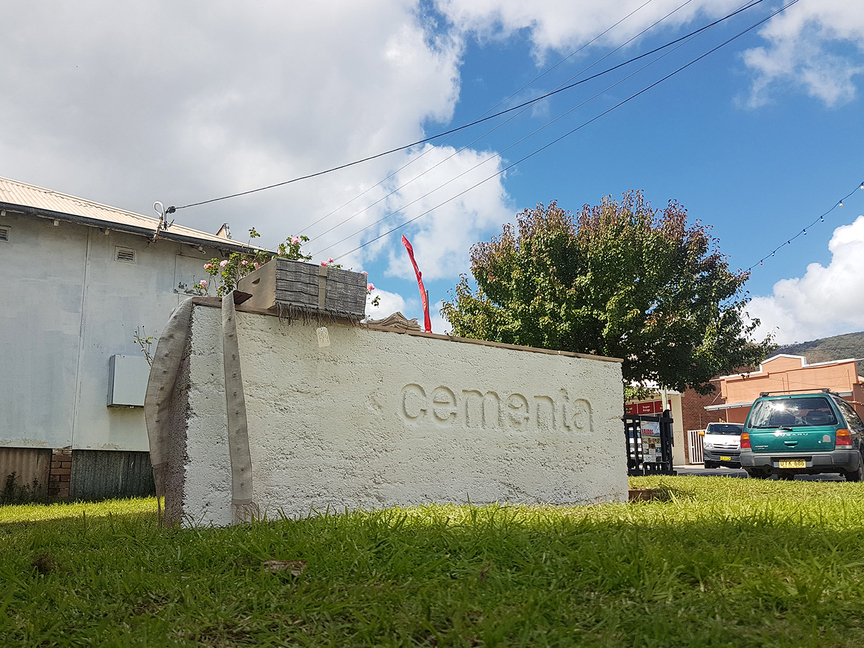For the first Cementa festival in 2013, Blue Mountains-based artist Ian Milliss created a poster for the town of Kandos and the fictional Kandos School of Cultural Adaptation, imagining a future-focused town in which a Solar Thermal Plant had replaced the use of fossil fuels and the old cement silo had been repurposed as a diving training center. Fellow artist GILBERT GRACE has taken up the challenge to turn fiction into reality, beginning with an attempt to help local farmer STUART ANDREWS obtain a licence to grow low-THC hemp on his nearby property, Marloo. Grace’s hempcrete ceremonial gate formed a focal point for the artist’s daily talks revealing the complicated history and broad potential of this fascinating material. All photos by Chloé Wolifson for ArtAsiaPacific.
Adjacent to the hempcrete wall was ANNE GRAHAM’s installation, House of Shade and Shadows (2017) where visitors were invited to sit, drink a bowl of homemade soup, and make their own small no-dig garden.
TERRY BURROWS has recently escaped the city, taking refuge in Kandos. Once settled, Burrows found his inflatable kayak an ongoing presence in his home and a reminder of those who travel vast distances in similar inflatable craft as refugees.
Simultaneously anonymous and highly noticeable, LINDA BRESCIA broke down barriers to
communication with her roving performance, entitled Don’t Worry I’m an Artist (2017).
Working out of the local hairdresser (Cuts Colours N Curls Hair Salon, 29B Angus Avenue, Kandos), THOM ROBERTS interpreted the crowns of visitors’ heads, creating unique landscapes through tracing paper which he then expanded into more complex illustrations.
TONY ALBERT’s practice includes the collecting and recontextualizing of “Aboriginalia,” the artist’s term for kitsch and naïve portrayals of Aboriginality. At the Honeytree Café on the Kandos main street, Albert’s installation, Untitled (Service Trays) (2017), featured many identical vintage service trays.
A collaboration between Wiradjuri and Ngiyampaa artist GRAHAM DAVIS KING, Blue Mountains-based artist BILLY GRUNER and architect CRAIG JOHNSTON, the Gnurra Gnurra (2017) brought together traditional and contemporary building techniques and aesthetics in the creation of a traditional indigenous hut. The ground, inscribed with symbols and patterns of the local Dabee culture, became a site for a daily performance.
STUART ANDREWS, who continues his father Peter’s pioneering work with Natural Sequence Farming, led visitors through a demonstration of how he is rehabilitating his property Marloo through this sustainable, experimental practice. A trickle of water from the hose and a few strategically-placed rocks served as an introduction before the group moved down the hill to see the process at full-scale.
Much to the delight of the teenage girls of Kandos, Powerhouse Youth Theatre brought the Dauntless
Movement Crew to town. The young parkour protégées ran, tumbled and jumped over the spectacular
pagoda rock formations of Ganguddy, drawing more than a few anxious gasps from the crowd.
Much to the delight of the teenage girls of Kandos, Powerhouse Youth Theatre brought the Dauntless Movement Crew to town. The young parkour protégées ran, tumbled and jumped over the spectacular pagoda rock formations of Ganguddy, drawing more than a few anxious gasps from the crowd.
This project saw seven New South Wales-based artists paired with seven New York-based artists, each tasked with installing the other’s work. Sydney-based CONNIE ANTHES (whose work Untitled Dissent/Descent was performed on NYC’s Lower East Side) hung KYLE FORD’s mixed-media yellow blankets with clothes pegs through the bush. The project was part of the exhibition “Correspondence of Imaginary Places,” curated by Sarah Breen Lovett.
As in any community, reactions to the contemporary art festival by residents of Kandos are mixed. Enthusiastic locals BORIS HUNT and DAVE STANDFIELD welcomed Cementa by concocting their own unofficial performance work, consisting of a soundtrack and live performance by Hunt in the local radio studio, broadcast through the streets by a gang of bicyclists adorned with transistor radios, led by Standfield. The ride included about 15 cyclists of all ages, and the live broadcast moved through the streets in a wheeled procession.
Colloquially, a bush telegraph refers to the rumor mill. Sydney artist-run initiative FRONTYARD moved
surreptitiously through the town during Cementa, posting snippets of conversation on telegraph poles,
inviting contemplation, controversy and reflection throughout the festival.




